Mary Pat McGuire and Jessica M. Henson
Applied Research & Design
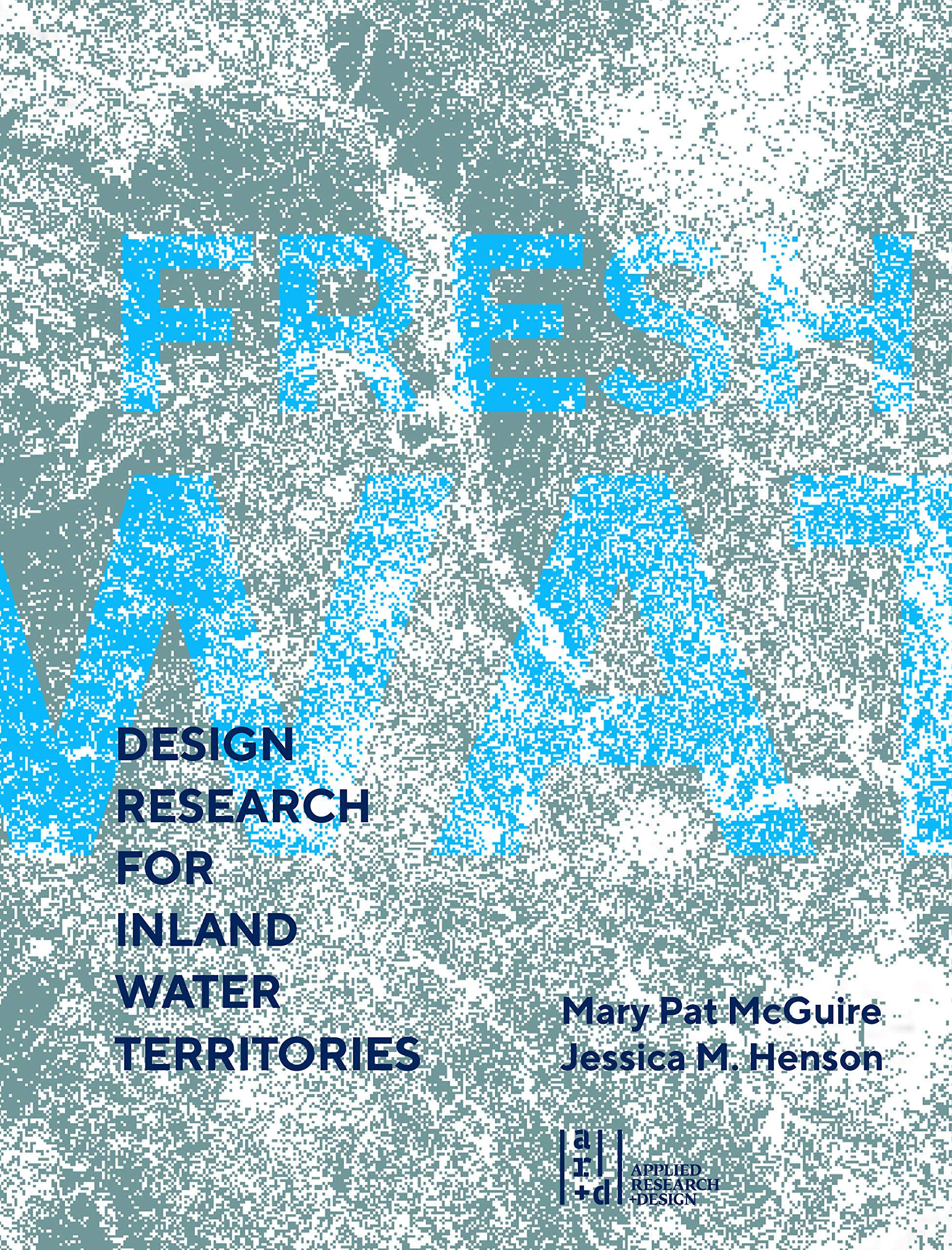
At a time when visions of the future come shrink-wrapped in Anthropocene-induced guilt, an analysis of the state of our water systems could make for difficult reading, so it’s heartening to find that Mary Pat McGuire and Jessica M. Henson, editors of Fresh Water: Design Research for Inland Water Territories, make a compelling case for critical design intervention to address this critical issue. The book layers two narratives: a clear-eyed overview of the degraded state of American water systems and a portfolio of design research projects by landscape architects that navigate the murky legacy of water control intervention to show how we might build a resilient “hydrosocial” landscape.
In this book, design research sets a way forward because it allows landscape architects to balance an object/process relationship essential to overcoming the greatest challenges for water systems in a coupled social, ecological, and technical ecosystem.1 Landscape Architect Joan Nassauer, for instance, claims that design shapes objects (particular landscapes) that can be experienced through analytical processes that insert human agency in geographic time and space.2 Tim Brown, an early evangelist of design thinking, suggests that it uncovers hidden processes that guide action. Although his early career focused on the design of better objects, Brown argues now that design thinking’s greater objective is to inform and transform decision-making itself.3 In his introductory essay, Lowell Duckert builds upon Bruno Latour’s notion of design as the “antidote to founding, colonizing, establishing, or breaking with the past . . . to hubris and to the search for absolute certainty, absolute beginnings, and radical departures” (13). Design in this sense is sticky—it grabs onto traces from the past; it imprints and feeds back upon the landscape; it forever transforms the people who live in that place. Overall, the editors demonstrate design thinking through landscape architecture to link social engagement, spatial planning, and historical analysis with data-intensive scientific research, engineering, and ecological restoration.
Over the last few decades, landscape architects have envisioned a central role for water in our future landscapes. In his essay, Billy Fleming asks if landscape architecture is living up to its promise of big change. Designers have developed the technical capability and interactive processes to imagine and implement a radically different future for our waterways. We can see this ambition in both international competitions and designs for new urban parks. Yet rivers have been straightened, marshes drained, and bays polluted. What difference does design practice (or design scholarship) make if the levers of control are outside the profession’s reach? In response, Fleming argues for an ethical framing of the profession. He sees “lines of activism” (22) in Anne Spirn’s work with the Mill Creek neighborhood of West Philadelphia, and he praises Kristi Cheramie and Matthew Seibert’s project to create “lines of imagination” (22) through “parafictional design research” (39).
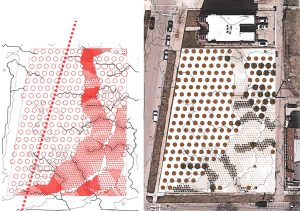
According to M. Elen Deming, it is metaphor—a term meaning to “carry across”—that enables designers to overcome the crushing complexity, scale, and opacity of water challenges. Deming suggests that “metaphor serves as a visual or poetic bridge between meaning, linking two conceptual shores” (85). Metaphor allows designers to transcend the real—if only for a moment—to enable new understandings of what could be. In “Points, Lines, and Planes: Depave Chicago,” Mary Pat McGuire uses a metaphor of “unmaking” the city. She wants to perforate the concrete-encased surface with surgical incisions to recharge the hydrologic sponge that lies below, revealing a dormant landscape.
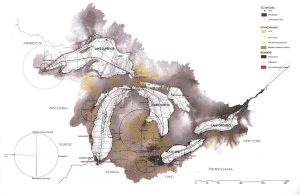
In an essay on “Port Futures: Revaluing Rivermouths in the Great Lakes Basin,” Sean Burkholder and Brian Davis look beyond the city to focus design interventions on the pressure points where river and waterbody meet. Through physical modeling and other design explorations of “newly possible” land-shaping potentials, the authors present the meeting of port and city as an opportunity; for them, the port is not simply a necessary infrastructure where damages should be minimized but a place to restructure ecosystems and catalyze the ecological health of the entire watershed.
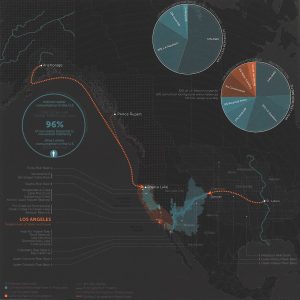
Danika Cooper claims that water is shaped not only by landforms (lakes, rivers, bays) but also by us. She writes that our shaping of water, “through an engineered channel, or held rigidly in place—tells us about a society’s value toward it” (146). For example, we assume that navigable waterways are controllable. Stripped of any connection to the ecosystem, water becomes bound up with transactional value as little more than a conveyor of goods. In “De-Naturing Preservation: Technological Landscapes of the Illinois River Valley,” Danielle Choi discusses the value systems of “preservation, conservation, restoration” (152) that have shaped landscape decisions for decades. Such value bias shapes the landscape that we enjoy, learn from, and must determine how to protect. The final design research project in the book, described in “Hydrosocial Territories of the Anthropocene” by Matthew Tucker, introduces modern water as the inert and quantifiable “utilitarian water that we know today,” defined around its excesses or insufficiencies. Tucker suggests that we turn toward “hydrosocial discourse” for it “reveals and re-maps our understanding of who and what determines why, where, and how water flows” (186). He finishes with design speculation as a tool to take on the “oncoming paradoxes of the Anthropocene” (190).
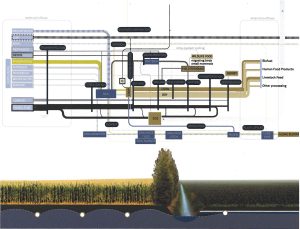
This book presents optimistic, transformative, and achievable actions that should inform an audience beyond the profession. However—and here is my only critique—the authors repeatedly return to how their design approaches define (and are defined by) the discipline of landscape architecture instead of running with the greater achievement this work represents for design and design research—as suggested by its provocative title. Unlike engineers, who gladly extend their influence into domains from medicine to information and industrial production, we designers, through our preoccupation with subdisciplines, underestimate the impact that our research has in the world. Springing from landscape architecture but expressing potential far beyond the confines of a single discipline, this book presents a way forward through design that acknowledges human impacts, placing human aspirations—as complex as they are—as the force driving the future.
Endnotes:
- See Samuel Markolf et al., “Interdependent Infrastructure as Linked Social, Ecological, and Technological Systems (SETSs) to Address Lock‐in and Enhance Resilience,” Earth’s Future 6, no. 12 (2018): 1638–59.
- Joan Nassauer, “Landscape as Medium and Method for Synthesis in Urban Ecological Design,” Landscape and Urban Planning 106, no. 3 (2012): 221–29.
- Tim Brown and Roger Martin, “Design for Action: How to Use Design Thinking to Make Great Things Actually Happen,” Harvard Business Review 93, no. 9 (2015): 3–10.
Jeff Carney is an associate professor at the University of Florida (UF) School of Architecture and associate director of the Florida Institute for Built Environment Resilience (FIBER). The institute is committed to the design, planning, construction, and management of resilient built environments, with strong interests in the wellbeing of the people and communities who inhabit them. Jeff leads the Florida Resilient Cities program, which works with communities across the state to connect resilience challenges with UF faculty and students through design research opportunities.
How to Cite This: Carney, Jeff. Review of Fresh Water: Design Research for Inland Water Territories by Mary Pat McGuire and Jessica M. Henson, JAE Online, June 5, 2020. http://www.jaeonline.org/articles/review/fresh-water#/.






